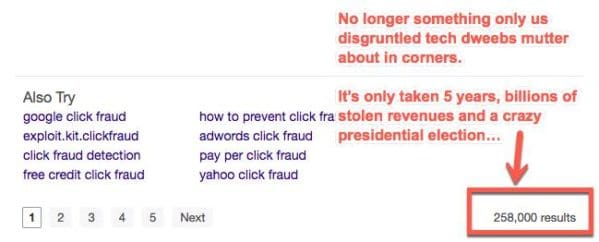Are we about to see advertisers “flee to quality”?
And would a complete overhaul of digital advertising be good for journalists and netizens who produce honest, high-quality content (and more importantly, bad for Fake News)? Mark Thompson, the CEO of the New York Times (a publication that now is the poster child for abandoning advertising in favor of subscription revenue), unloaded on the complex ad-delivery technology that’s arisen in the past 10 years, pointing out all the flaws that have been glaringly evident to anyone who has paid attention to the space. Do a quick search for “clickfraud” and count backwards to when the articles started appearing – hell, I’ve been yammering about it on this blog for at least 5 years myself.

Not just the sheer number of results – check out the related searches as well. Right out there in the open: tools for you to launch your very own online fraud business.
And yes, the events of the past year, that saw utter fraudsters making bank off Fake News sites, seems to have finally shaken advertisers and publishers out of their stupor.
Still, it was bracing to see a major CEO speak in such blunt terms (“nightmarish joke,” “creepy, borderline fraudulent middlemen”) about the current online advertising ecosystem, particularly when for so long, so many people tiptoed around the subject, afraid of either looking ignorant of the technology (usually not in the skillset of a 60-something CEO), or pissing off the advertisers (can’t basically call them idiots and then turn around and ask for their money).
You know that things have gotten bad when having someone actually acknowledge reality seems like a heretical move. But this is where we are; where we’ve been for quite a long while (at least in internet-time).

Hard to imagine that these were once cutting-edge computer displays; or that they would grow into “the” way that billions of people get their news, entertainment and connect with friends.
So yeah. Everyone is participating in online ad exchanges. Why? Because that’s where the money is.
But that begs the question: why is the money there? This is where it gets interesting:
What’s the upside of ad tech?
Efficient transactions. It’s not just cheaper than using human beings but also simply more effective, and the fact that you can get a good sense of the audience you’re trying to reach.
Although I have to say, close examination of some of the segmentation that’s been claimed in digital advertising might be lifting a few more logs.
You mean data accuracy?
Yeah. When we say someone is a member of the audience is a female fashionista aged 20-30, what’s the probability that that’s actually true?
Digital advertising: can we really rely on circumstantial evidence?
Ahhhh… yes. There’s the rub. I’ve spent quite a great deal of time with my head stuck inside Google Analytics (and other online analytics packages). The question posed there at the end: how do we know that the person that we’re buying through this exchange is actually what’s being delivered … is one that has never been resolved to my satisfaction.
Yeah, sure, you can cookie the shit out of a user on Facebook and then connect that digital identifier to behavior, friends, geo-location, browsing habits, likes, etc. But as we’ve seen with the Fake News sites, all that kind of metadata can all be faked, spoofed or duplicated by bots.
Think of it: If I can make it seem like I’m an honest accountant in Muncie, when I’m actually a hacker in Hunan, how hard is it really to create profiles that then click on ads in bot-nets? A first-year CompSci student could write a randomization script to do that and implement it in time for happy hour. And probably has.
So what’s in the cards? Well, as more & more fraud starts infecting the automated systems, they are going to grow less & less efficient. And efficiency, as noted above, is their one value proposition. If they start to not perform, then we’re going to see a shift towards something that does actually perform.
The CEO of the New York Times is betting that this involves the ads appearing on sites where their context is decent, honestly produced content. If he’s right, then there is about to be a huge shift away from the programmatic ad networks that are making so much money as middlemen right now (and not coincidentally, towards sites such as NYTimes.com).
